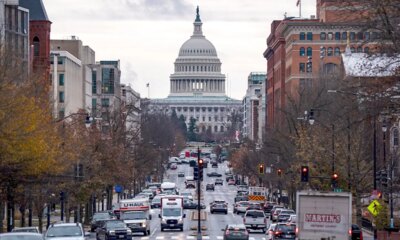California
Lakers News: LA Reveals Schedule for July’s California Classic Summer League

The 2024 NBA offseason is officially underway. This summer will be the biggest to date for the Lakers, as they have a bunch of vital decisions to make in the coming weeks. While all the talk will be on the decision-making of Los Angeles brass regarding the roster and coaching staff, basketball will be played this summer, starting with the 2024 California Classic Summer League.
It will give us our first chance at getting a look at the rookies and undrafted players the Lakers targeted.
The Lakers will participate in three games, all held in San Francisco. The Lakes will play from July 6-10, starting with the Sacramento Kings at 1:30 p.m. P.T. The next game will be on July 7 against the Golden State Warriors at 3:30 p.m. P.T. The final game before the team heads to the Las Vegas Summer League, L.A., will play the Miami Heat on July 10 at 4:00 p.m. P.T.
The NBA will have the California Classic Summer League in Sacramento from July 6-7 and 9 and in San Francisco from July 6-7 and 10. The NBA will also hold the Salt Lake City Summer League from July 8-10. The NBA 2K25 Summer League in Las Vegas will be from July 12-22.
The Lakers will look to hit on all cylinders this summer, including Summer League.
More Lakers: Key Offseason Dates for Los Angeles

California
Rain continues in parts of California reeling from flooding and high tides – WTOP News

CORTE MADERA, Calif. (AP) — Crews cleared mud from key California highways as forecasters warned Sunday that more thunderstorms were…
CORTE MADERA, Calif. (AP) — Crews cleared mud from key California highways as forecasters warned Sunday that more thunderstorms were on the way after downpours and high tides caused flooding, road closures and rescues of people trapped in cars.
Five northern counties remained under a flood watch, with up to three inches (7.6 cm) of rain possible through Monday night in areas that have been drenched off and on since around Christmas, said the National Weather Service office in Eureka. At least a foot (.3 meters) of snow was likely in the mountains.
To the south near the San Francisco Bay Area, waters were slowly receding after roadways from Sausalito to San Rafael were flooded during heavy rain that coincided with record-breaking “ King Tides.” Such tides occur when the moon is in its closest position to the Earth, creating a stronger gravitational pull.
Some people kayaked along swamped streets, while others waded through water above their knees. Authorities were called to assist when cars got stuck in water as high as 3 and 4 feet (1.1 and 1.2 meters), Marin County Sheriff’s Sgt. Michael Dobbins said Saturday.
“I’ve been around here for the King Tides and I’ve never seen it this high. Never,” Jeremy Hager of San Rafael told KTVU-TV.
Flooding was reported across Marin, Sonoma, Alameda, San Mateo and San Francisco counties.
While the tides were waning, lingering thunderstorms on Sunday could cause additional problems throughout low-lying areas, forecasters said. “For anyone driving, slow down and allow extra time to reach your destination,” the Bay Area office of the weather service warned on social media.
Farther south in Santa Barbara County, a key highway was reopened Sunday after it was blocked for most of the weekend near Goleta due to a series of mudslides. A man died after he was swept into a creek during the storm, the sheriff’s office said Saturday.
Parts of Santa Barbara County received more than four inches (10 cm) of rain over two days, the weather service said Sunday.
After a mostly dry autumn, California has been hit by a series of powerful winter storms that brought the wettest holiday season to the state in years.
Copyright
© 2026 The Associated Press. All rights reserved. This material may not be published, broadcast, written or redistributed.
California
California’s gubernatorial race heats up as Newsom’s term nears end, with many contenders

FRESNO, Calif. (FOX26) — In just over a year, Gavin Newsom’s term as California’s governor will come to an end, capping off nearly eight years in office.
Now the question is – who will take over once he steps down?
We spoke to political scientist Nathan Monroe about what could be one of Californias most unpredictable gubernatorial races yet.
With Governor Gavin Newsom’s term ending, the race to replace him begins.
This race will determine who leads the worlds fifth largest economy at a time when California is facing issues such as housing and affordability.
Californias next gubernatorial election is shaping up to be crowded – and for the first time in years – there’s no incumbent on the ballot.
“You say, well, just which democrat is going to win, right? Like, sort of republicans don’t have a shot. But what we have to keep in mind, right, is that the rules of elections matter. And in California, we have the top two primary system,” said Nathan Monroe, a Political Science Professor at UC Merced.
More than a dozen candidates are vying for the spot.
On the democratic side, contenders include former U.S. Secretary of Health and Human Services Xavier barrera, former U.S. Representative Katie Porter, Representative Eric Swalwell, former Los Angeles Mayor Antonio Villaraigosa, and former State Controller Betty Yee.
Political experts say the size of the field could make turnout and name recognition decisive and could lead to unexpected results in the primary.
“But if you divide that pie up by just two, and you divide the democratic pie up, which is admittedly a larger pie, by 7 or 8, the concern you get here is that democrats are going to lose out on even running to the general election. So even though there might be more democratic votes to be found in California for governor, they might not have a shot to cast those ballots for a democrat on the general election ballot,” said Monroe.
Monroe says party leaders may need to step in soon.
“I think the concern has to be among voters and I’m sure among the party leaders, so to speak, right, the party leaders sort of amorphously, is that they’ve got to figure out a way to delicately, you know, assure some candidates out of the race and figure out which candidates those should be and figure out how to manage those personalities and try to coordinate all the things that go in and around a gubernatorial election,” said Monroe.
On the Republican side, former Riverside County Sheriff Chad Bianco and Fox News contributor Steve Hilton.
With just a few months from the midterm elections, Monroe says both parties need to organize.
“What’s happening behind the scenes for the parties to try to coordinate themselves to make sure that the field that they offer to voters in June is a field that gives them the best chance for their best candidate to go forward to the general election,” said Monroe.
The primary election is set for June, with the general election in December.
California
Heavy rain, high tides cause flooding along stretch of Northern California
CORTE MADERA, Calif. (AP) — Heavy rain and high tides believed to be the most severe in two decades caused flooding in parts of Northern California on Saturday, prompting road closures and rescues of residents trapped in their cars.
Roadways through a 15-mile (24-kilometer) stretch from the Sausalito area to San Rafael were flooded after a downpour coincided with record-breaking “ King Tides,” Marin County Sheriff’s Sgt. Michael Dobbins said.
No injuries were reported but authorities were called to assist when cars got stuck in floodwater as high as three and four feet (1.1 and 1.2 meters), he said.
“There is a lot of water in the roadways,” Dobbins said, adding the tides were reportedly the highest in more than two decades. “Along with heavy rains, it just created the perfect storm for flooding on the streets.”
Authorities in the communities near San Francisco asked residents to stay home wherever possible until waters recede. Some residents kayaked along what normally would be city streets. Others waded out in water that passed their knees.
A flood warning was in place for the San Francisco area until 2 p.m. Saturday and an advisory until 2 p.m. Sunday, according to the National Weather Service in San Francisco.
King Tides occur when the sun, moon and Earth are in alignment and the moon is in its closest position to the Earth, creating a stronger gravitational pull.
-

 World1 week ago
World1 week agoHamas builds new terror regime in Gaza, recruiting teens amid problematic election
-

 Indianapolis, IN1 week ago
Indianapolis, IN1 week agoIndianapolis Colts playoffs: Updated elimination scenario, AFC standings, playoff picture for Week 17
-

 Business1 week ago
Business1 week agoGoogle is at last letting users swap out embarrassing Gmail addresses without losing their data
-

 Southeast1 week ago
Southeast1 week agoTwo attorneys vanish during Florida fishing trip as ‘heartbroken’ wife pleads for help finding them
-

 World1 week ago
World1 week agoSnoop Dogg, Lainey Wilson, Huntr/x and Andrea Bocelli Deliver Christmas-Themed Halftime Show for Netflix’s NFL Lions-Vikings Telecast
-

 Politics1 week ago
Politics1 week agoMost shocking examples of Chinese espionage uncovered by the US this year: ‘Just the tip of the iceberg’
-

 News1 week ago
News1 week agoRoads could remain slick, icy Saturday morning in Philadelphia area, tracking another storm on the way
-

 World1 week ago
World1 week agoPodcast: The 2025 EU-US relationship explained simply


















